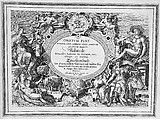Title Page, "Omnium Pene Europae, Asiae, Aphricae atque Americae Gentium Habitus"
Abraham de Bruyn Flemish
Publisher Joos de Bosscher Netherlandish
Not on view
This engraved title page by Abraham de Bruyn introduces his 1580 volume The Costumes of the Various Nations of Europe, Asia, Africa and America (Omnium pene Europae, Asiae, Aphricae atque Americae Gentium Habitus). At its pinnacle, de Bruyn depicts a roundel showing a bearded man riding a horse while the angel of death flies above him. The inscription notes that: 'C'est en vain' (it is in vain), and is perhaps a warning about all of the earthly riches seen in the engraving and made manifest in the terrestrial globe seen in the lower foreground.
The extended title of the costume book is written on the oval panel at center placed within an architectural framework with scrolling strapwork, flanked by the allegorical female figures representing the four continents. European artists from the Renaissance onwards visualized the known world through allegorical figures derived from ancient Egyptian, Greek and Roman personifications. The allegorical figures often took the form of female bodies. Early versions of the Continents featured only three but when Europeans reached the Americas in 1492, the Continent was added to the existing representations of Europe, Asia and Africa. These images and their hierarchical arrangements reinforced ideas of the self and the other steeped in white Christian and male Eurocentrism.
Typically these female allegorical figures are endowed with the attributes of their lands and became standardized in texts and images. On the upper left, the allegorical figure representing Asia sits on a column. She is dressed in a beautifully draped dress with a jeweled armor. She is accompanied by a bird, similar to a parrot, and a miniature camel that stands before her on the top of a column. Below Asia sits the allegorical figure representing Africa. She is shown nude, reclining, holding a fruit and a feather fan, wearing jewels and with a headdress of wheat stalks, all demonstrating the natural riches of the African continent. Below her is Africa, laying nude on a piece of draped fabric, touching the water that flows on the lower part of the print. She wears a beaded necklace with a jeweled pendant and pendant earrings with pear-shaped stones. Her hair is tied back and flanked by a crown made up of exotic flower buds. She holds a round fruit on her right hand and a jeweled fan with feathers on the left. She is accompanied by an elephant. At the upper right is the equally sexualized figure of America, who is shown nude except for a feather headdress and cape. She holds a bow and is accompanied by a small dog-like animal. Surprisingly, as representations of the Four Continents often show Europe as a queen reining over the other continents and given her pride of place in the upper register at the left, de Bruyn has placed her at the bottom right. Here Europe is shown riding off on the back of a bull. This narrative is not traditionally allegorical, but rather finds it source is ancient mythology--the abduction of Europa by Zeus.
Below her is Europe, dressed with a draped dress under a short cuirasse with jeweled brooches, her hair tied up by a wreath of flowers and leaves, from which hangs a jeweled pendant onto her forehead, and her feet shod with long, lace-up sandals. She rides a bull, which is half-sunk on the water, and grabs it by the left horn. On the right hand she holds another wreath of flowers and leaves. Next to her, flanking the frame, is a horse.
This image cannot be enlarged, viewed at full screen, or downloaded.

